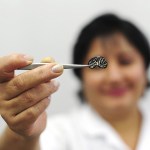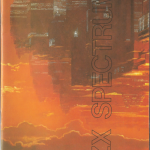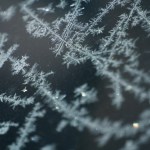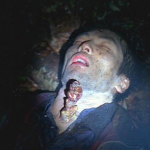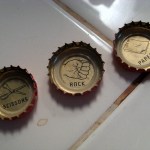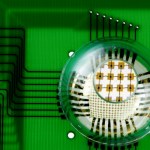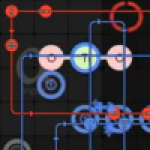Annalisa Crannel has written an interesting article for Inside Higher Ed on using art to teach mathematics. Of particular interest is how artists and mathematicians approach problems differently - the former willing to stumble toward the answer while the latter hold off until they're sure they have the right one.
We all know and can parody the dreaded two-trains problems. A simpler question is this: If you sketch a picture of the rails of the train track going into the distance, and you know where the first two railroad ties go, where do you put the next one? In our class, we change the…

Science is awesome.
Click the image to biggify.
The European Southern Observatory says:
The first European antenna for the Atacama Large Millimeter/submillimeter Array (ALMA) has reached new heights, having been transported to the observatory's Array Operations Site (AOS) on 27 July 2011. The 12-metre diameter antenna has arrived at the Chajnantor plateau, 5000 metres above sea level. Here, it joins antennas from the other international ALMA partners, bringing the total number at the AOS to 16.The plateau's elevated location -- 2100 metres higher than the OSF -- gives it the extremely dry…
In the early hours of a Wednesday morning two weeks ago, three Greenpeace activists made their way past the perimeter fence at Ginninderra Experiment Station in Canberra, Australia, and destroyed a crop of GM wheat using weed strimmers. A spokeswoman for Commonwealth Scientific and Industrial Research Organisation (CSIRO), the national science agency which runs the station, said the damage was estimated to run A$300,000. In a statement released by Greenpeace Australia Pacific, activist Laura Kelly stated that "We had no choice but to take action to bring an end to this experiment".
Both…
Last May I heaved myself out of bed a little before 5am so I could undertake a mammoth 12 hour round trip to that pantheon of industrial decay, Rotherham. What did the home of Jive Bunny and the Chuckle Brothers have to entice me on such a journey? Why, only Science World 2011, Fisher Scientific's annual trade fair. And their keynote speaker for the day, the Baroness. No, not that Baroness. I'm talking about Professor Susan Greenfield, who has made something of a name for herself with her theories about the effects of the internet on the brain. Namely, that the pervasiveness of digital…
No sooner than the smell of low Earth orbit had worn off the space shuttle Atlantis, Nature editor Adam Rutherford was stitching together footage of its final mission into this wonderful tribute to the golden age of manned spaceflight.
Adam says:
I've made a short music video for Nature and Scientific American marking the end of the Space Shuttle era. It consists of every single one of the 135 missions, in order, set to the a music of 65daysofstatic. It is my love letter to the Space Shuttle.The editing was done by Charlotte Stoddart and Dave Holloway, and the music was remixed by Paul…
I miss the 80s, when computing manuals were illustrated with things far removed from home computing. I found this amongst my pop's old computing books.
Nowadays off-the-shelf programming software tends to be designed for a specific purpose, and I like to think that the artist here was trying to capture the infinite possibilties that lay ahead at the dawn of home computing, but perhaps I'm just being sentimental.
Wait, there's more!
YouTube artist and multi-instrumentalist Michael John Blake has been exploring the musical patterns within mathematics, by assigning each note on the major scale a numeral. In this wonderful composition he plays Tau, a number used in a similar way to Pi, for calculating values of circles and whatnot.
From Lockheed Martin, a shot of an F-35 (the US stealth-capacity joint strike fighter) torching a blast deflector. I'd love to know what causes those bands in the exhaust flare. Also, check out the badass fireman in the foreground!
From source:
LAKEHURST, N.J., July 7th, 2011 -- F-35C Lightning II carrier variant aircraft CF-2 is performing Jet Blast Deflector (JBD) tests at Joint Base McGuire-Dix-Lakehurst in New Jersey. The JBD, located behind the catapults aboard aircraft carriers, deflects high energy exhaust from the engine to prevent damage and injury to other aircraft and personnel…
The British Film Institute in London is celebrating the 50th anniversary of Yuri Gagarin's historic flight with KOSMOS, a season of films dedicated to Soviet sci-fi.
Snip:
Part two of KINO will be presented in conjunction with the 50th anniversary celebrations of Yuri Gagarin's momentous journey into space. KOSMOS will provide an introduction to Russian and Soviet science fiction from the periods leading up to and after Gagarin's expedition as the first human to orbit space. The season will offer rarely seen films and key documentaries in a programme that explores the impact of the Soviet…
Following on from last week's discovery of water that can freeze at room temperature, here's another trick. Water at minus 130 degrees Celsius can flow like a thick fluid. The work carried out by Ove Andersson, a physicist at Umeå University, showed that by increasing pressure to 10,000 times the norm, ice could be coaxed into a viscous liquid state 30% denser than normal water. The findings lend support to the theory that water has two liquid phases, one at much higher density than the other. I'd imagine it also means liquid water is likely to exist even on frozen planets.
As someone…
Artist Mike Bodge has unveiled a nifty project to chart the colour of the sky above New York City in real time. A camera installed in his office snaps a picture of the skyline every five minutes, and analyses the image to calculate its average colour. The varying shades of blue, grey, orange and black are posted online in a never-ending mosaic.
Mike says:
Many of my projects tend to be about New York City, as it's a place i'm constantly inspired by. I have a great view at my office overlooking the East Village neighborhood and I've done time lapses and other things but none really…
From the Journal of Things Kurt Vonnegut Warned Us About, Japanese scientists have discovered a way to make water freeze at room temperature.
Image CC Nicholas Bufford
The team of scientists were investigating the properties of water molecules wrapped in single-atom thick carbon nanotubes. The nanoconfined water displayed several unusual properties. Most striking was that as the width of the carbon nanotube decreased, the melting point of the water trapped inside rose. These "tubule ices" are unlike any seen in bulk water, and can even occur at room temperatures.
Thankfully, there's no…
Extremophiles are superhardy microbes that can live in some of the toughest environments Mother Nature provides - from the frozen wastes of the Antarctic to highly-acidic mine tailings. Now you can add your kitchen to that list.
A paper published in the journal Fungal Biology details the discovery of a novel type of fungus found living on the rubber seals of dishwashers. Zalar et al. sampled 189 machines in over a hundred towns and cities across the world. A plethora of fungal species were recovered, including some harmful to human health.
We all know this is how it ends.
Fungi such…
Important news from the University of Washington: allowing bacteria to play rock paper scissors teaches them the value of restraint.
Image CC Mike Souza
Researchers created a group of E. coli bacteria locked in a non-transitive game of survival. Non-transitive refers to situations where each player is weak against another in the field, such as rock-paper-scissors. One type of bacteria produced two antibiotics, the remaining bacteria were either resistant to the antibiotics, or sensitive to them. All three types were dropped into 192 wells, between which they could migrate.
On occasion…
The Smithsonian has a cool post on wingless ants that have learned how to glide through the forest canopy using their outstretched legs. If knocked from their treetop nest, Cephalotes atratus avoid falling to the ground by steering themselves, tail first, back toward the tree. Yes, not only can these ants glide, they do it backwards.
Full details over at the Smithsonian Science blog.
When the judges sat down to award this year's $500,000 Lemelson-MIT prize for innovation, there were a slew of fantastic inventions to choose from. Implantable computers, ultra-low-cost cameras, a revolutionary solar panel design. Luckily for the judges all three were invented by one man: Dr John A Rogers.
Seemingly cut from the same cloth as previous Lemelson-MIT recipient and Renaissance man Erez Aiden (see Ed Yong's excellent piece here), Roger's creations have spanned a disparate collection of sciences, and he himself credits his success to an appreciation for both science and the…
So the other week there was collective quivering over the internet at the news that a Chinese teenager had sold his kidney to pay for an iPad 2. I say quivering, because It was an immediate viral hit, a perfect combination of the pre-eminent SEO-friendly technology, body horror, stupid-teens-making-dumb-decisions-for-latest-must-have-item narrative and a conveniently obscure provenance, as if the story had been precisely manufactured by the same Shenzhen factories that Apple uses to make its gadgets.
And so, the world rolled its eyes and tutted at the foolishness of youth and decried Steve…
It's been a while since we had some Friday Flash Fun here at SciencePunk, but this one really blew me out of the water.
SpaceChem is currently causing quite a stir amongst the gaming websites: Escapist Magazine gave it the Genre Buster award and Rock Paper Shotgun hailed it as "one of the year's best indie games". Deservedly so, in my opinion.
SpaceChem puts you in the shoes of a junior materials chemist, blasted into the depths of space to work for a pan-galactic mining corporation. Your job is to build complex molecules from the basic chemicals mined out of these planets. At your…
Sometimes you wake up and you think of a really good idea and then after a couple of hours trying to find out how QR patterns are encoded you remember to Google your idea and find someone's already done it.
But I don't mind. Check out this sweet QR code clock by QR Planet.
In case you're wondering, a QR code is simply a two-dimensional barcode. It's a way of packing a lot of machine-readable data into a small space. QR patterns can encode URLs, text, phone numbers, and contact details. You can scan them with your cameraphone if you have the right software - there's plenty of free…
So a few weeks back we had a super-nerdy science party, and I thought you might like to know how to mount your own. So here's how to make delicious desserts that look like bacterial cultures. This works builds on previous research carried out by Rehorst et al.
You'll need:
Petri dishes
Jello
Rice pudding
Angel Delight
Lab notebook
Protective clothing
Rum (optional)
Jelly sweets
Food colouring
Icing for decorating cookies
And any of the following: cocoa, brown sugar, maple syrup, cake decorations, chocolate drops...
Click below the fold for more....
1. Collect your ingredients. If you're…

